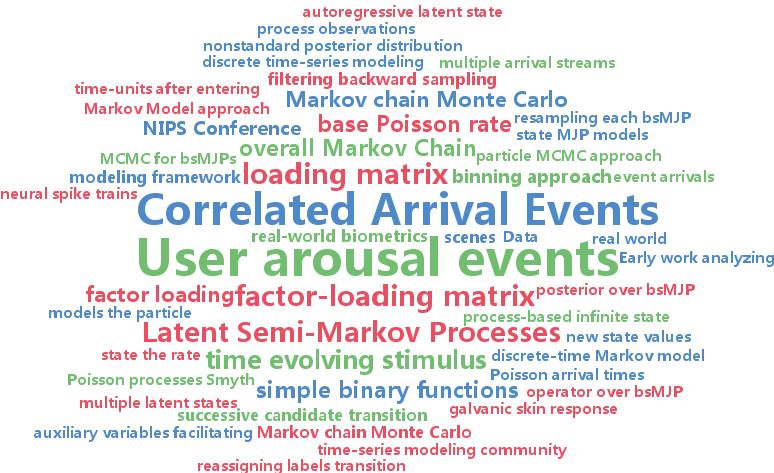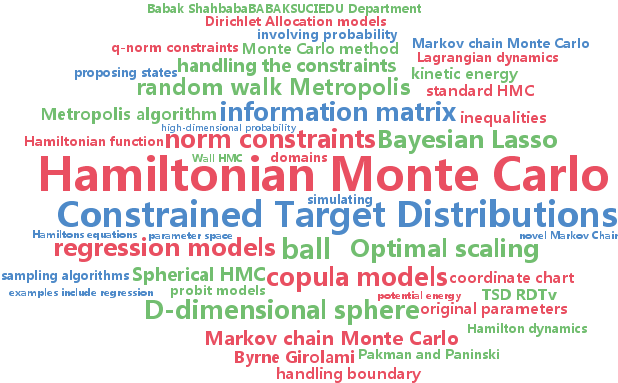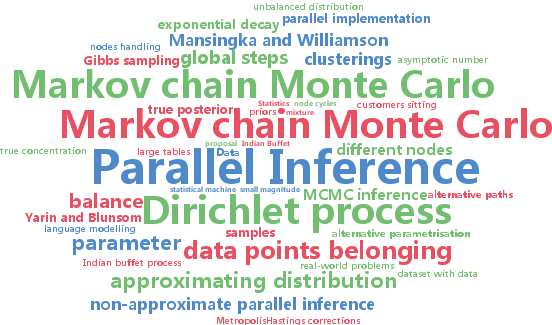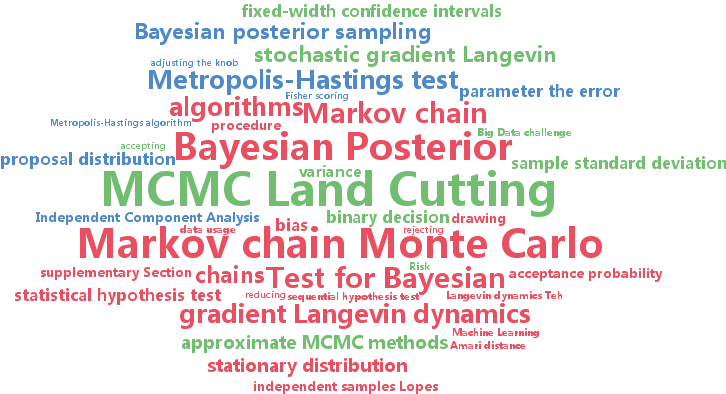markov chain monte carlo
-
Wenzhao Lian and Vinayak Rao and Brian Eriksson and Lawrence Carin
Modeling Correlated Arrival Events with Latent Semi-Markov Processes (pdf)
The analysis and characterization of correlated point process data has wide applications, ranging from biomedical research to network analysis. In this work, we model such data as generated by a latent collection of continuous-time binary semi-Markov processes, corresponding to external events appearing and disappearing. A continuous-time modeling framework is more appropriate for multichannel point process data than a binning approach requiring time discretization, and we show connections between our model and recent ideas from the discrete-time literature. We describe an efficient MCMC algorithm for posterior inference, and apply our ideas to both synthetic data and a real-world biometrics application.
-
SHIWEI LAN and Bo Zhou and Babak Shahbaba
Spherical Hamiltonian Monte Carlo for Constrained Target Distributions (pdf)
Statistical models with constrained probability distributions are abundant in machine learning. Some examples include regression models with norm constraints (e.g., Lasso), probit models, many copula models, and Latent Dirichlet Allocation (LDA) models. Bayesian inference involving probability distributions confined to constrained domains could be quite challenging for commonly used sampling algorithms. For such problems, we propose a novel Markov Chain Monte Carlo (MCMC) method that provides a general and computationally efficient framework for handling boundary conditions. Our method first maps the $D$-dimensional constrained domain of parameters to the unit ball ${\bf B
-
Creighton Heaukulani and David Knowles and Zoubin Ghahramani
Beta Diffusion Trees (pdf)
We define the beta diffusion tree, a random tree structure with a set of leaves that defines a collection of overlapping subsets of objects, known as a feature allocation. The generative process for the tree is defined in terms of particles (representing the objects) diffusing in some continuous space, analogously to the Dirichlet and Pitman-Yor diffusion trees (Neal, 2003b; Knowles & Ghahramani, 2011), both of which define tree structures over clusters of the particles. With the beta diffusion tree, however, multiple copies of a particle may exist and diffuse to multiple locations in the continuous space, resulting in (a random number of) possibly overlapping clusters of the objects. We demonstrate how to build a hierarchically-clustered factor analysis model with the beta diffusion tree and how to perform inference over the random tree structures with a Markov chain Monte Carlo algorithm. We conclude with several numerical experiments on missing data problems with data sets of gene expression arrays, international development statistics, and intranational socioeconomic measurements.
-
Monir Hajiaghayi and Bonnie Kirkpatrick and Liangliang Wang and Alexandre Bouchard-Côté
Efficient Continuous-Time Markov Chain Estimation (pdf)
Many problems of practical interest rely on Continuous-time Markov chains~(CTMCs) defined over combinatorial state spaces, rendering the computation of transition probabilities, and hence probabilistic inference, difficult or impossible with existing methods. For problems with countably infinite states, where classical methods such as matrix exponentiation are not applicable, the main alternative has been particle Markov chain Monte Carlo methods imputing both the holding times and sequences of visited states. We propose a particle-based Monte Carlo approach where the holding times are marginalized analytically. We demonstrate that in a range of realistic inferential setups, our scheme dramatically reduces the variance of the Monte Carlo approximation and yields more accurate parameter posterior approximations given a fixed computational budget. These experiments are performed on both synthetic and real datasets, drawing from two important examples of CTMCs having combinatorial state spaces: string-valued mutation models in phylogenetics and nucleic acid folding pathways.
-
Christopher Tosh and Sanjoy Dasgupta
Lower Bounds for the Gibbs Sampler over Mixtures of Gaussians (pdf)
The mixing time of a Markov chain is the minimum time $t$ necessary for the total variation distance between the distribution of the Markov chain's current state $X_t$ and its stationary distribution to fall below some $\epsilon > 0$. In this paper, we present lower bounds for the mixing time of the Gibbs sampler over Gaussian mixture models with Dirichlet priors.
-
Yarin Gal and Zoubin Ghahramani
Pitfalls in the use of Parallel Inference for the Dirichlet Process (pdf)
Recent work done by Lovell, Adams, and Mansingka (2012) and Williamson, Dubey, and Xing (2013) has suggested an alternative parametrisation for the Dirichlet process in order to derive non-approximate parallel MCMC inference for it work which has been picked-up and implemented in several different fields. In this paper we show that the approach suggested is impractical due to an extremely unbalanced distribution of the data. We characterise the requirements of efficient parallel inference for the Dirichlet process and show that the proposed inference fails most of these requirements (while approximate approaches often satisfy most of them). We present both theoretical and experimental evidence, analysing the load balance for the inference and showing that it is independent of the size of the dataset and the number of nodes available in the parallel implementation. We end with suggestions of alternative paths of research for efficient non-approximate parallel inference for the Dirichlet process.
-
Jascha Sohl-Dickstein and Mayur Mudigonda and Michael DeWeese
Hamiltonian Monte Carlo Without Detailed Balance (pdf)
We present a method for performing Hamiltonian Monte Carlo that largely eliminates sample rejection. In situations that would normally lead to rejection, instead a longer trajectory is computed until a new state is reached that can be accepted. This is achieved using Markov chain transitions that satisfy the fixed point equation, but do not satisfy detailed balance. The resulting algorithm significantly suppresses the random walk behavior and wasted function evaluations that are typically the consequence of update rejection. We demonstrate a greater than factor of two improvement in mixing time on three test problems. We release the source code as Python and MATLAB packages.
-
Tianqi Chen and Emily Fox and Carlos Guestrin
Stochastic Gradient Hamiltonian Monte Carlo (pdf)
Hamiltonian Monte Carlo (HMC) sampling methods provide a mechanism for defining distant proposals with high acceptance probabilities in a Metropolis-Hastings framework, enabling more efficient exploration of the state space than standard random-walk proposals. The popularity of such methods has grown significantly in recent years. However, a limitation of HMC methods is the required gradient computation for simulation of the Hamiltonian dynamical system-such computation is infeasible in problems involving a large sample size or streaming data. Instead, we must rely on a noisy gradient estimate computed from a subset of the data. In this paper, we explore the properties of such a stochastic gradient HMC approach. Surprisingly, the natural implementation of the stochastic approximation can be arbitrarily bad. To address this problem we introduce a variant that uses second-order Langevin dynamics with a friction term that counteracts the effects of the noisy gradient, maintaining the desired target distribution as the invariant distribution. Results on simulated data validate our theory. We also provide an application of our methods to a classification task using neural networks and to online Bayesian matrix factorization.
-
Rémi Bardenet and Arnaud Doucet and Chris Holmes
Towards scaling up Markov chain Monte Carlo: an adaptive subsampling approach (pdf)
Markov chain Monte Carlo (MCMC) methods are often deemed far too computationally intensive to be of any practical use for large datasets. This paper describes a methodology that aims to scale up the Metropolis-Hastings (MH) algorithm in this context. We propose an approximate implementation of the accept/reject step of MH that only requires evaluating the likelihood of a random subset of the data, yet is guaranteed to coincide with the accept/reject step based on the full dataset with a probability superior to a user-specified tolerance level. This adaptive subsampling technique is an alternative to the recent approach developed in (Korattikara et al, ICML'14), and it allows us to establish rigorously that the resulting approximate MH algorithm samples from a perturbed version of the target distribution of interest, whose total variation distance to this very target is controlled explicitly. We explore the benefits and limitations of this scheme on several examples.
-
Anoop Korattikara and Yutian Chen and Max Welling
Austerity in MCMC Land: Cutting the Metropolis-Hastings Budget (pdf)
Can we make Bayesian posterior MCMC sampling more efficient when faced with very large datasets? We argue that computing the likelihood for N datapoints in the Metropolis-Hastings (MH) test to reach a single binary decision is computationally inefficient. We introduce an approximate MH rule based on a sequential hypothesis test that allows us to accept or reject samples with high confidence using only a fraction of the data required for the exact MH rule. While this method introduces an asymptotic bias, we show that this bias can be controlled and is more than offset by a decrease in variance due to our ability to draw more samples per unit of time.
-
Diederik Kingma and Max Welling
Efficient Gradient-Based Inference through Transformations between Bayes Nets and Neural Nets (pdf)
Hierarchical Bayesian networks and neural networks with stochastic hidden units are commonly perceived as two separate types of models. We show that either of these types of models can often be transformed into an instance of the other, by switching between centered and differentiable non-centered parameterizations of the latent variables. The choice of parameterization greatly influences the efficiency of gradient-based posterior inference; we show that they are often complementary to eachother, we clarify when each parameterization is preferred and show how inference can be made robust. In the non-centered form, a simple Monte Carlo estimator of the marginal likelihood can be used for learning the parameters. Theoretical results are supported by experiments.
-
Brooks Paige and Frank Wood
A Compilation Target for Probabilistic Programming Languages (pdf)
Forward inference techniques such as sequential Monte Carlo and particle Markov chain Monte Carlo for probabilistic programming can be implemented in any programming language by creative use of standardized operating system functionality including processes, forking, mutexes, and shared memory. Exploiting this we have defined, developed, and tested a probabilistic programming language intermediate representation language we call probabilistic C, which itself can be compiled to machine code by standard compilers and linked to operating system libraries yielding an efficient, scalable, portable probabilistic programming compilation target. This opens up a new hardware and systems research path for optimizing probabilistic programming systems.











